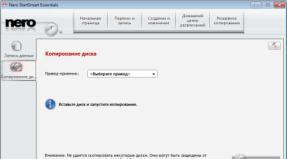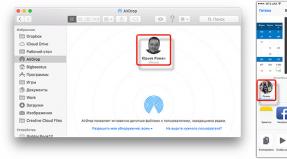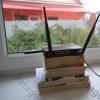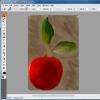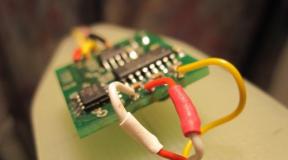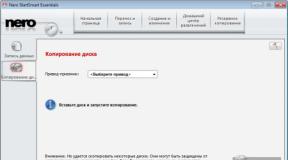How to remove photos on your phone from your laptop. Simple ways to transfer photos from your phone to your computer. Using a cloud drive
Now even on the simplest push-button phones there is a camera, not to mention smartphones. Very convenient, the “camera” is always at hand. Taking a photo is easy and simple, but the screen size seems small with age, I would like to look at the photo larger, or share it with loved ones and friends. There is a desire to transfer photos from your phone to your computer. I'll try to tell you how to do this.
There are a great many models of phones and smartphones. Each specific case has its own peculiarities of connecting and transferring photos. It is impossible to tell about each model, I will try to explain general principles, which will help you solve this problem.
Modern phones They have a universal charger that connects via a microUSB – USB connector. To connector Computer USB we need to connect. Older phones had different, often suitable only for a given phone model, connectors. But if there is a USB connector from your phone, then that will also work. Here is a drawing of USB types.
To enlarge the picture, click on it with the left mouse button, return to the previous size - again
Under the numbers 1 – USB, 2 – miniUSB, 3 – microUSB.
We connect the cable to the phone, and connect the other side to the computer. After the first connection, it tries to automatically install the necessary drivers (as we remember, a driver is a program that connects our device, in this case a phone, and the computer’s operating system). An icon appears on the taskbar 
In the picture it is highlighted with a red frame, here is a larger one, the same picture. If you click on it, a window will open in which we can see the installation progress.
The example shows the connection of an LG Leon smartphone. 
After installation, a new icon appears in the “My Computer” window  – “LG Leon”, circled in red in the picture.
– “LG Leon”, circled in red in the picture.
After clicking on it with the left mouse button, a new window opens in which we see two disks. 
You may have one if you don't have a memory card installed. In our example, this is “ Inner memory and CD Card.” Open the “Internal Memory” folder.  Here we see a lot of folders. We are interested in the DCIM folder, this is the phone's camera folder.
Here we see a lot of folders. We are interested in the DCIM folder, this is the phone's camera folder.
Let's open it. There are service folders and a “Camera” folder. 
We open it, here are photos from our photo module. 
If, like ours, the files are listed, click “View” and select 
“Small icons” or “ Large icons” (More details on how to change the view in.)
Next are the standard actions - right-click on the photo we have selected, select “Copy” in the menu that opens, go to the “Pictures” computer folder, or you can right-click again on the “Desktop” and select the “Paste” menu item. Our task is completed, the photo from the phone is transferred to the computer.
Comment:
If you have a memory card in your phone, and the phone settings indicate saving photos on it, then there will be no photos in the DCIM folder in the phone’s internal memory. All of them will be saved in the same folder - DCIM on the CD card.
Now let's look at another case. When you connect your phone to your computer for the first time, a driver installation error occurs, or the driver is installed, but the phone does not appear in the “My Computer” folder. You can try going to the phone manufacturer's website and finding required driver and install it manually. But this is a rather difficult task, and not everyone will be able to do it.
What to do in this case? Is there any other option for solving the problem “Transfer photos from phone to computer”. Yes, if you have internet on your phone (via WiFi or mobile). We go to e-mail on the phone (I hope you already have a mailbox, if not, you can create one - instructions.) and write a letter to yourself, attach the desired photo or several and send it. The email you sent appears in your inbox. On your computer, go to your email and save the attached photo on your computer. The problem is solved.
In contact with
Modern mobile devices with Android OS can perform functions inherent in many digital gadgets, including cameras. And if you use this tool often, then free place on a smartphone sooner or later ends and with each full-length photo shoot the question arises of how to transfer photos from Android to a computer.
Photos are transferred to a computer, of course, not only to free up phone memory. Viewing a slideshow on a big screen is much more comfortable, and a smartphone breaks down more often than a computer; you have to “destroy” all the data, which can lead to you losing photos.
There are several ways in which you can solve the problem, now I will tell you about them.
Using a USB cable
On a Windows PC
First we need to provide a USB connection. To do this, connect your computer and smartphone via a USB cable, after which a message will appear on the screen that the connection has been established, press the “ Enable USB drive", after reading the system message about the possible stop of some applications, click " OK", the green Android will turn orange and the display will indicate that the USB drive has been activated:

On some versions Android connection may look different: as a result of pairing the Android device with the computer, a window will appear in which you need to select the USB connection parameters, in our case we select “ Media device (MTP)«:

Now, if you have the " Autostart“, then a window will appear on the computer screen where you need to select “Open device to view files”:

Or on PC click " Start", choose " Computer" (or " My computer") and double-click to open the photo storage location - " MicroSD" or " Inner memory" (some models may appear as an "F", "E" or something else):

The objects of interest to us will be located in the following directories: photographs in DCIM, screenshots should be found in Pictures, and pictures downloaded from the Internet to Download:

So, in DCIM open the folder " Camera"and we see photos in it; you can transfer them to any folder on your PC:
- Right-click on the desired photo and select “ Copy"Then right-click in the folder to select" Insert«.
- Select an object (or group of objects) and use hotkeys Ctrl+C copy, then Ctrl+V insert.
- Simply drag one or more photos (after selecting them) either into a folder or onto the desktop.

On computers with OS X
We connect our Android to an Apple computer using a USB cable and unlock the screen. On the PC we find the application “ Image Capture"(which is located in the folder " Applications"), open it, and in it we find our smartphone:

In the menu that opens, select the location in which we will save the selected photos. Now, if we plan to transfer all the pictures, click “ Import All" To transfer individual objects, select them by holding down the " Command" and click on the selected pictures, and then click " Import».
Using cloud services
Transfer your photos to your computer from Android smartphone possible using one of the cloud storages. We'll take a look at what such a transfer would look like with the Google-Drive client.
The vast majority of Android device users have Google account(if you don’t have it, then how to create it on Android,). All we have to do is install the application Google Drive from Google Play, launch it and enter the login and password for your account Google posts. Then we activate the function " Download" and select the photos that we will place on the disk:

Now we can log into our account on the computer from the browser and call up the Google services menu, select “ Disk«:

On home page select the section " Google Photos"and we see there photographs that were imported from the smartphone, they can be left on the disk and viewed when needed, or they can be copied to a folder or to the desktop, as described above. Or you can download the Disk to your PC (button in the lower left corner) and then all content, including photos, will be available on your computer without an Internet connection:

Let's watch a video about other cloud storages:
Via BlueTooth
If among wireless adapters Our computer has bluetooth, then we proceed as follows:
On your phone or tablet, you need to enable device visibility; to do this, go to “ Settings", turn on the Bluetooth connection, click on the line " BT"(the first fragment in the screenshot), and in the function settings we set visibility.
Now we activate BlueTooth on the PC (section " Computers and devices"). If such a connection is made for the first time, then we will need to enter a special password transmitted by the system on both devices. After pairing is confirmed, a Bluetooth connection will be established.
Now open the “Gallery” on Android, find the desired photo, click on it and hold your finger for a couple of seconds until the fork icon appears on the top panel, click on it and in the drop-down menu of possible actions select “ VT"(BlueTooth). The process of searching for devices will begin. Select your computer from the list that opens:

This makes it convenient to transfer individual photos or files; transferring packets is unlikely to be justified due to the length of the wait and possibly incomplete transfer.
If the PC does not support BlueTooth, then you can buy a special Bluetooth adapter with a disk. After installation, the “VT” icon will appear in the panel quick launch, click on it and select “Accept file” or “Send” from the menu that appears.
Using special software
Friends! We told you how to download photos from Android to your computer using the most common and simple tools. Write in the comments how clear the material was presented and whether it helped you. Ask your questions and you will definitely receive a detailed answer. And for today we have nothing more to add. Good luck!
Modern smartphones have more or less passable built-in cameras that allow you to take fairly high-quality pictures. Of course, professional photographers will find many shortcomings with these cameras. But most ordinary users are satisfied with the quality of pictures taken with the built-in camera, so they often use their smartphones for photography when they don’t have a high-quality camera at hand. Moreover, modern ones have significantly increased the level of quality of such photographs.
After filming on a phone, the user may need to transfer the captured photos from the phone to a computer to perform various tasks: creating an archive with photos on the PC, editing material in graphic editors(the functionality of editors for smartphones is limited and often inconvenient), creating presentations, etc. You can transfer photos from your phone to your computer different ways , some of them are discussed below in this article.
The charging cord can be used not only for its intended purpose (charging a smartphone), but also for exchanging information between a smartphone and a computer. Using a charging cord to transmit information is most reliable, since when wired connection There is no signal loss, the connection is stable and constant. Of course, provided that a high-quality cord is used and the PC and phone are in good working order.
To transfer photos from your phone to a computer, the charging cord must be connected at one end to the phone connector and the other to the computer (as a rule, the connection to the PC is made via a USB interface). The computer must detect the smartphone, sometimes for this you need to install the drivers yourself, but in most cases the OS either installs them itself or does not require installation of the latter at all.
Next, the differences begin based on the operating systems installed on the smartphone and PC. However, all user actions generally boil down to the following actions: select a connection method and actually transfer photos from the phone to the computer.
Microsoft Corporation occupies the largest share of the OS market, so the following procedure for how to transfer a photo from a phone to a computer via a cable is determined using Windows as an example, but in general the algorithm is universal for all operating systems:
How to transfer photos from your phone to your computer wirelessly
In some cases, for various reasons, the user cannot use the charging cord to transfer photos to the computer. In this case, you need to know how to transfer photos from your phone to your computer wirelessly. Data transfer can be carried out via wireless connection (Wi—Fi or Bluetooth) PC and smartphone. It is also possible to use for these purposes various cloud services and file storage, a card reader for connecting an SD card from a phone to a PC. But that’s not all, here are listed only the simplest ways to transfer photos from your phone to your computer without using a wire.
Wireless methods of transferring photos from a smartphone to a PC are not always reliable and guarantee data safety, and some of them require additional equipment or Internet access. Unlike transferring photos from your phone to your computer via a charging cord, the main advantage of wireless data transfer methods is their number and variety. From the entire list of them, you can choose the most suitable one in a specific situation, which will satisfy the requirements of reliability and speed of transmission, and the availability of equipment. If the user does not have a high-quality charging cord, he should use the methods below to transfer photos.
Transfer photos via Bluetooth
Bluetooth– one of the most common wireless network specifications. Can be used to exchange various data between devices that support it, including transferring photos from a phone to a computer. The data transfer speed and transmission distance depend on the Bluetooth version supported by the devices. For 2018 latest version This wireless connection is Bluetooth 5.0.
If modern smartphones almost 100% equipped Bluetooth modules, then not all computers are equipped with them (most often laptops have them). For PCs, you often have to purchase separate Bluetooth modules.
Transferring photos via Bluetooth is not particularly reliable (especially over long distances) and speed (primarily older versions), but it also has some advantages: widespread use, ease of use and low power consumption (starting with Bluetooth 4.0). To transfer photos using this wireless network, necessary:
- Enable Bluetooth on your phone and computer;
- Select the photos on your phone that you want to transfer;
- Select sending via Bluetooth in the corresponding item in the phone’s context menu;
- Confirm receipt of files on your computer;
- Wait for the photo transfer to complete.
Sometimes you need to pair your devices before sending files, and sometimes this happens automatically the first time you transfer files.
Transferring photos via cloud storage
To transfer photos from your phone to your computer, you can use cloud storage. This option requires an Internet connection on both devices. Data transfer speed depends on the speed of your Internet connection. This method wireless transmission files has undoubted advantages: fairly high reliability, high communication range (data can be transferred from anywhere in the world where there is Internet), ease of use.
Cloud storage allows you to transfer a fairly large amount of photos for free. Thus, Yandex.Disk provides 10 GB of virtual space when registering with the service. Google, Mail.ru and many others have similar services. The choice of service is not important; the user can use any of them at will. You can read the article about. Also, most likely, it will be useful for you to learn how to take photos and videos from your phone.
To transfer images from your phone to your computer, follow these steps:
- Upload photos from your phone to a cloud service;
- Log in to your account on your computer cloud service, where the necessary files are stored;
- Download photos from the service to your PC.
Yandex.Disk has a convenient application for Windows that allows you to work with files on the cloud without downloading them directly to your computer. The application can help if you are running out of space on your PC storage. It should be noted that Google also has a similar application.
Transferring photos using a card reader
You can use a card reader to wirelessly transfer photos from your phone to your computer. This method of transmitting information is quite simple and reliable, plus it has a high speed of photo transfer, but requires additional equipment (card reader and micro SD card).

Meet this card reader that reads a lot of flash drive formats
Card readers differ in connection type. USB card readers are the most common, as this is the most popular connector for connecting devices and accessories to a computer. SD card readers are also widespread.
To transfer data via a card reader you must:
- (optional). Move or copy the photos you want to transfer to your phone's micro sd. Skip this item if photos are saved to micro sd by default;
- Remove the micro sd from the phone and insert it into the card reader;
- Connect the card reader to the appropriate computer interface;
- Wait for definition micro computer sd;
- Copy or move photos from micro sd to a computer, having first found the files on the micro sd using the OS.
The methods of how to transfer photos from a phone to a personal computer wirelessly, in comparison with how to transfer taken photos from a phone to a computer via a cord, differ in the requirement for some equipment that the user may not have. A charging cord is a necessary addition to any phone, so the wired method of data transfer is more universal. However, wireless photo transfer methods also have some advantages. The article does not list all the ways to transfer photos from a smartphone to a PC, only the simplest of them that can be used by inexperienced user. However, simplicity in this case does not imply a bad result.
Did you read to the very end?
Was this article helpful?
Not really
What exactly did you not like? Was the article incomplete or false?
Write in comments and we promise to improve!
Instructions
We insert the flash drive that we removed from the camera into the card reader. Next, the computer detects the device and you can read information from the flash card in the same way.
Video on the topic
Sources:
- upload photos from camera
The popular VKontakte service is not only a powerful and largest social network, but also convenient storage a huge number of media files, including - count and images. If you find photos on a website that you would like to have on your computer, then your most common action will be mechanical saving photos one at a time in certain folders. However, if photos much, this procedure will take too long. You can simplify your task by using the VKMusic 4 program, which allows you to upload photos from VKontakte albums in the highest published quality.

Instructions
VKMusic program(versions 4 and higher) is absolutely free, takes up little space on your hard drive, has an intuitive, simple interface, and in addition to the convenient function of downloading audio from the site, it can also effectively upload photos in entire albums that you specify for.
A window will open in which top line you need to enter a link to the album that requires downloading, and in the bottom line you need to indicate the folder in which the photos will be saved.
Check to see if a green checkmark appears next to the link line - if it appears, the link is correct and the album can be downloaded. Indicate in the line below the exact path to the directory to save the files.
After that, click the button with the plus sign and the words “Download photo album.”
Sources:
- The best funny photos online for free - look
Nowadays, with many gadgets, it is quite easy to store and move information. Flash cards, players, s, cameras interact with each other very easily. The main thing is to learn how to connect them.

You will need
- Telephone
- Card reader
- USB cable
- Bluetooth
Instructions
For the first method of transferring photos from to a computer, you will need a special USB cable that will connect the computer to each other. There are some that work when connected in flash drive mode, but some may require a special driver. When the phone is initialized by the system, photos can be copied as usual from the media to the computer.
Video on the topic
note
When transferring photos via Bluetooth, it is better not to press any keys on the phone so that there is no failure in data transfer.
When uploading photos, it’s better to use copying so that you have them on your phone just in case. backups.
Sources:
- how to transfer photos from phone to computer in 2018
The Internet has made it possible for people at a distance
from each other, to communicate freely with each other. Now they can exchange messages, make voice and video calls, and also send files, including photos.

You will need
- Computer, Internet access, email client, or Account in one of the mail services.
Instructions
Open the desired folder and select the photos you want to transfer to memory. This can be done using the left mouse button while holding down the Ctrl key. Without releasing the button, drag objects into the created resource.
If there is no USB cable, use a card reader. It contains connectors for various memory cards; there is sure to be one suitable for yours. Insert the media into the device. Wait until the green or light turns on and the removable drive appears in the My Computer folder. The further sequence of actions is the same as when using the transmission cord.

Instructions
The most convenient are those with removable memory cards. Purchase a card reader from a computer accessory store that is compatible with the card installed in the device. Find out in the instructions for whether it is necessary to perform any additional actions before removing the card from it (close all applications, select a special item in the menu, turn it off). Carry out these steps if necessary, and then remove the card. Place it in the card reader (depending on the design of the latter, directly or through an adapter). Connect the card reader to your computer, and it will be recognized (regardless of the OS) as a regular one. Find a folder with photos on the card (usually called Images) and move it to HDD computer in the same way as if you were transferring them from . Next, disable the card reader using the OS (also similar), disconnect it physically, remove the card from it and install it back into the phone. If the last one was turned off, turn it on.
A phone with a non-removable memory card will have to be connected directly. Take it with you to the store and ask for the appropriate cable. At home, connect it to your computer with this cable. Perhaps, immediately after this, a menu with several connection options will appear on the mobile phone screen (“Modem”, “Storage”, PictBridge and so on). Select the mode called “Storage” (on some devices - “Removable disk”). After this, it will be recognized as a flash drive, and it will be possible to transfer files from it to the computer’s hard drive, as indicated above.
There are phones that can be connected to a computer, but cannot work in flash drive emulation mode. There are two ways to work with them. The first is to connect a Bluetooth device to the car (it usually has one). In the file manager phone Select the image you want to transfer, and then select your computer as the receiving device. When the latter accepts the file, indicate in which folder it should be saved. The second method involves installing a software package downloaded from the phone manufacturer's website. Please note that this package most likely will not work on Linux.
Very cheap camera phones may not have a memory card, a connector for connecting to a computer, or Bluetooth. The only way to extract images from them is to use MMS. Contact your operator to find out if their unlimited sending service is available in your region. Typically it allows you to send up to 300 such messages per day. subscription fee about 60 rubles per month. Please note that if a regular MMS message can have a volume of up to 300 kB, then one sent as part of this service is often no more than 150. Include several pictures in the message, the total volume of which does not exceed the specified size. Instead of the sender's number, enter your own address Email. Send an MMS, and in a couple of minutes you will find photos (most likely in reduced form) in your email mailbox. In the same way you can send Pictures and on if you agree that the recipient will know your phone number.
Video on the topic
Tip 15: How to transfer photos from your phone to your computer
Have accumulated in your mobile phone photos that you want to send to computer? In theory, this can be done in several ways. Which ones are suitable for you in practice depends on the model and configuration of your phone and technical equipment of the computer.

You will need
- - data cable;
- - bluetooth adapter;
- - adapter and slot for reading memory cards;
- - BY.
Instructions
Transfer photos from your phone to your computer via bluetooth. If your computer does not have a built-in Bluetooth adapter, purchase an external one. After connecting the device to the computer, install the drivers - that’s it necessary files must be supplied with the adapter.
Activate the Bluetooth adapters of your phone and computer. Run a search on any of your devices. For example, on the phone. Find your computer in the resulting list. To confirm the connection, you will need to provide a code. Depending on your equipment, this code will be offered to you by the system (it will appear on the display of one of the devices, and you will need to enter it on the second) or you will need to set it yourself (in which case you will need to enter this code yourself in both devices).
Select the photos you want to download from your phone and transfer them to your connected computer using context menu your phone. If you have any problems, check your user manual. Or log in from your computer file system connected phone, select the photos you want and copy them using normal OS tools.
Connect your phone to your computer using a data cable - it should be included with your phone. If necessary, select a mode USB connections“File transfer”, etc. - Look for information in the user manual of your phone. Wait until the OS recognizes the connected device. If your phone comes with a driver disk, install them.
Make sure that the PC recognizes the phone connected via cable, and transfer the desired photos using standard means copying the OS. Or install special program to synchronize your phone with your computer - it must be supplied with the phone or distributed free of charge on the phone manufacturer's website.
Please note that if the photos are stored on a phone memory card, your computer has a card reader slot (Memory Stick, etc.) and you have a suitable adapter (usually these come with miniature calling cards), you can just insert your phone card into your computer and transfer photos via Windows Explorer.
Don't despair if you don't have a data cable and Bluetooth adapter at hand. If both your computer and phone are equipped with an Internet connection, you can transfer files by email. If alternative email address If you don’t have one and don’t want to create one, you can send photos to your e-mail using a regular MMS, and then download them from the received letter to your computer’s hard drive.

Instructions
If you need to download a picture quickly, but you don’t have a computer at hand, then use Mobile Internet. Having an email account on your cell phone, you can easily send photos by mail from your mobile phone to your PC email. Of course, this method also has some disadvantages, for example, the cost of services and the slowness of the process. But there are situations when you are on vacation and want to send a photo to your friend, then this option, of course, is simply irreplaceable.
Use the Bluetooth function. It enables the exchange of information between devices such as personal computers, Cell Phones, printers, laptops, digital cameras, etc. Bluetooth allows them to communicate with each other when they are located within a radius of up to 100 m from each other. Thus, there is a need for an appropriate USB device(a connector used to transfer data between a PC and a mobile phone) to connect to your computer. With this method, exchanging photos and other files from a PC is also quite simple.
Connect via Bluetooth function as follows. Select device by network name, enter the communication code, after which the connection will be established. Now you can exchange information.
Connect your phone to your computer with via USB cord. Any mobile model has a special program for working through such a wire. If it is not there, then transfer the desired photo to the flash drive in your phone. The computer will detect it without first installing a special program. All you have to do is transfer the data. Using this method, you can transfer many photos to your computer quite quickly.
You can simply send the image to another phone. Specify the recipient in your contact list to whom you will forward the photo. Now all you have to do is press the “Done” button, and the message will go to the desired subscriber. If this method for transferring files does not suit you, then try another option.
Use file hosting services. These resources provide users with space for various files and public access to them on the network. There are many similar services, but you choose the one that you like best and is easy to use. To do this, you need to open the photo on your phone and click the “Download” button on a specific resource page. After the download has occurred, you receive a link to download the file.
Tip 17: How to transfer files from computer to Samsung phone
Modern phones Samsung are positioned as full-fledged multimedia devices, supporting forms of content such as audio, photo and video. To download files, use one of the simple methods.

Instructions
The most common method is synchronization using a data cable. A data cable and drivers, as well as synchronization software, can be found in the phone package. If they were not included in the package, download the drivers from the official website samsung.com or from any of the company’s fan sites, and buy a data cable in the store cellular communications, or order online.
Install the software and drivers, and then connect the phone to the computer. Perform these steps in exactly this sequence. Launch the software and download files to the phone.
Many modern laptops are usually equipped with a Bluetooth module. If your computer is one of them, or you have the above-mentioned module at your disposal, and it is also present on your phone, activate it on your mobile and set the mode to “accessible to everyone”.
After that, run device startup from computer and find your phone. Send the files by confirming reception on your mobile phone. After this, wait until the transfer is completed and turn off the Bluetooth interface on your mobile phone.
If your phone has a memory card slot, remove it from your mobile phone. Connect the card reader to your computer and insert the card into it. Wait until it shows up as a removable hard drive. After installing the drivers, which should happen automatically, copy the files intended for sending to the phone to it. Safely remove the keypad from the computer and insert it back into the phone.
You can also use the services of free wap exchangers. Let's consider this method using http://www.amobile.ru/ as an example. Follow the link http://www.amobile.ru/wapload, then enter your nickname and verification numbers. Select " " from the list of phone manufacturers, then locate and download the file to be sent. Once the download is complete, you will be redirected to a page where you will see a download link. Follow the link from your mobile phone and download the file.
Video on the topic
Modern models mobile phones allow you not only to make calls and send or receive text messages, but also to photos relatively good quality. And sooner or later the need arises to copy the mobile phone to the hard drive computer. And it can be done different ways.

You will need
- Data cable or bluetooth adapters
Instructions
Via data cableConnect your phone and computer using a data cable. It should come standard with your mobile. Set the connection mode to “File transfer” (“Data transfer”, etc. - the exact name of the connection mode depends on the model of your mobile phone). If necessary, install drivers/software. They must be supplied with the phone, or freely distributed on the manufacturer’s website. If you have any difficulties, read the user manual.
Copy photos With phone using standard tools of your OS. Depending on the software the connected telephone can be recognized by the system as external drive. If you have a special synchronization program installed on your computer, copy photos With phone through her - detailed instructions how to do this, look in help system synchronization program or in the user manual phone
Via bluetooth adapter, use to copy photos from phone to a computer Bluetooth connection. If your computer does not have a built-in Bluetooth adapter, purchase and connect an external one. To establish a Bluetooth connection, enable the adapters on both devices. If you have any difficulties, consult the help system or user manual.
Enter the password for the bluetooth connection. Most often, it consists of four numbers that you must come up with yourself and enter on both devices. But it happens that the password is set by the system itself, and you will only need to confirm this code on the second gadget. After connection is established photos can be passed through the context menu phone or computer. Or, if this function is supported, through a special synchronization program supplied with the phone.
note
As a last resort, you can copy photos using MMS. Required files It will be enough to send it to your own email address, and then copy it from the received letter to your computer’s hard drive. However, for this personal account phone will be charged according to your tariff plan.
Helpful advice
Some older mobile phone models are equipped with infrared ports. To transfer photos in this case, you will need to purchase and connect an infrared port (IrDA adapter) to the computer and place both devices in close proximity, pointing the infrared ports at each other.
Related article
Cell phones and smartphones are often equipped with such convenient functional devices as camera. Image quality in latest models all manufacturers is quite high, and it can already be compared with the quality of images obtained by popular point-and-shoot cameras. WITH phone You can transfer photos to your computer in several ways.
In this article we will tell you how to transfer photos from your phone to your computer. Since the site is dedicated operating system Android, a smartphone running on this OS will be used as an example. By the way, it will be Samsung Galaxy. Please note that photo transfer will be done using USB cable(sometimes simply called a charger or charging cord). So, let's go.
The first thing you need is the cable itself. We think you know perfectly well what it looks like, but just in case, here is a picture showing a USB cable for a smartphone.

Connect the cable to your computer or laptop into a USB port on one side, and connect your smartphone to the other. Once you do this, the device should appear in the My Computer window. However, this applies to devices with old Android version, on more recent ones you must provide access to data on the phone. For example, on a Samsung Galaxy, a window will appear immediately after unlocking the screen, click “Allow” in it.

On some other devices it's a little more complicated. So, on Xiaomi you need to lower the curtain and click “Charge via USB”.

A small menu will appear in which you need to select “File Transfer (MTP)”.

The device is now reflected in the “My Computer” section on your PC or laptop. You open it.

As you can see, in our example there are two disks: Phone is the main one, Card is the memory card. You need to decide what to choose: usually the photos are located in the smartphone’s memory, but they can also be on a memory card. In our example, in the smartphone’s memory, which means we open Phone.

Here find the DCIM folder and open it. DCIM stands for Digital Camera Images.

Here you can see several folders, in our example these are Camera and Screenshots. The latter stores screenshots, but the Camera folder contains images taken with a smartphone camera.

A list of images is loaded. If there are a lot of them, this may take some time. Select the images, then click on the right mouse button to display a context menu and click “Copy”.

Now open a new window, then select the drive and folder on your computer to transfer files. If you already have the folder open, that’s great: hover your mouse over the empty space, right-click and select “Paste.”

The images were copied to a computer.

Using these instructions, you can transfer images from other folders. The main thing is to know which folder on your smartphone contains the images you need.
